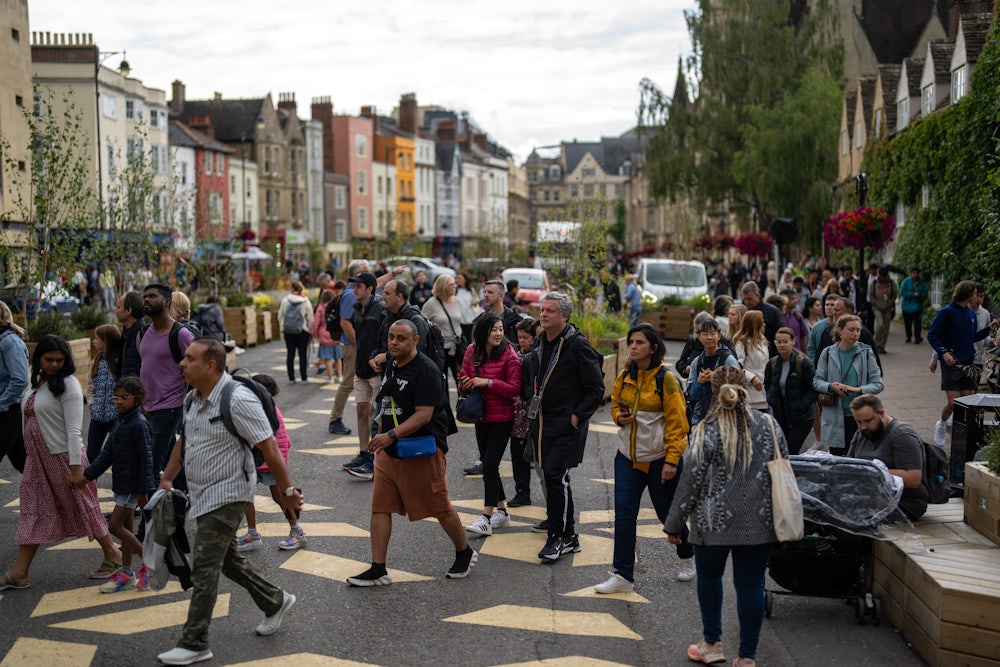Imagine you live in a town where everyday essentials like work, food, school, health care, and cultural activities all lie within a quick walk or bike ride from people’s homes. Your city has reduced residents’ reliance on car travel, freed you from your hellish commutes, and reconnected communities with one another. Public transit is reliable, concrete expanses have been transformed into lush green space, and carbon emissions are plummeting.

This was the idea sketched by Carlos Moreno, the Sorbonne University professor who pioneered the “15-minute city.” A computer scientist by training, Moreno spent the mid-2000s designing digital energy-management platforms to address urban sustainability. But he became convinced that tech-centered approaches would not solve cities’ problems. He began developing the 15-minute city idea, introducing it at the United Nations’ COP21 Climate Conference in 2015, and working with city leaders to test practices that could bring people closer to their needs and help improve environmental outcomes.
Then came the Covid-19 pandemic, which brought a flood of high-profile attention to the 15-minute city. A group of nearly 100 mayors committed to implementing it in some form as a means toward a climate-friendly recovery from the crisis. At COP26 in 2021, architects put the strategy at the center of discussions of sustainable city development goals. The World Economic Forum released slick videos and articles endorsing the 15-minute city.
It’s probably no wonder, then, that the 15-minute city eventually penetrated the tinfoil hats of the far right. In 2023, climate deniers, QAnon types, radical libertarians, anti-vaxxers, and white supremacists seized on the World Economic Forum’s elite support for the idea. Fringe narratives made it synonymous with “climate lockdowns” and the “great reset,” in which governments would confine residents to open-air prisons, restricting and surveilling their movements (and perhaps forcing them to eat bugs). Online conspiracists compared the 15-minute city to the Warsaw Ghetto. Reactionary self-help author Jordan B. Peterson called it a scheme by “idiot tyrannical bureaucrats” to tell you where you’re allowed to drive. Moreno, in the normal course of events, became a lightning rod for insane abuse and death threats.
Conspiracists have little to fear, as Moreno’s resolutely non-sinister new book, The 15-Minute City: A Solution to Saving Our Time and Our Planet, makes plain. To the decades of poor urban planning that have hastened climate emergency and caused dire “fragmentation,” Moreno poses a utopian solution: “happy proximity.” “We seek to foster mixed-use urban neighborhoods and living spaces that build strong links between people, strengthen social cohesion, and promote a better quality of life,” he writes. The book outlines a moderate program for a sustainable urban future, in which city officials enact incremental policy changes—more bike paths, better public transit, broader green space—that largely rely on private capital and pose little threat to the political status quo. But the thinking behind these features also evokes a more radical egalitarian vision, one that could decentralize work, improve neighborhood solidarity, and help end exploitative economic relationships, expanding our free time and reducing neighborhood displacement along the way.
Our current predicament owes, in part, to the planning principles of the twentieth century. The Athens Charter, a 1933 document published by renowned architect Le Corbusier and the International Congress of Modern Architecture, promoted the “radiant city,” an idealized plan that would zone urban areas for distinct uses: high-rise residential districts surrounded by green space, with separate industrial and commercial zones, all connected by high-speed transportation infrastructure. This aim to rationalize modern cities became enormously influential in postwar planning worldwide.
But the radiant city had its discontents. The construction of highways in places like New York and Paris wiped out whole neighborhoods, separated communities, and damaged the environment. Residential areas sprawled into the suburban outskirts. Car dependency and long commutes to work became the norm, eating into people’s precious free time. (Later came gentrification, as affluent suburbanites returned to the urban core.) “This expansion,” Moreno writes, “has occurred at the expense of proximity, community, and the traditional activities of city life, such as local markets, walks, and urban nature.”
Some modern thinkers fought to preserve more traditional neighborhood cohesion. In the midcentury, activist Jane Jacobs and her neighbors shot down a proposed highway that urban planner Robert Moses aimed to build through Lower Manhattan, and residents of Amsterdam kept their city bike-friendly by rejecting a destructive development plan. Meanwhile, some workplaces tried teleworking as early as the 1970s as a means of reducing commutes—it was an attempt at “bringing work to the worker”—but neither the tech nor the incentives for employers were strong enough to sustain it. Today, Moreno argues, we must again take up Jacobs’s call for cities that operate at a “human scale.”
In order to foster greater proximity, Moreno favors the idea of the “neighborhood unit,” in which cities are divided into autonomous, self-sufficient areas that provide residents with access to all essentials. He promotes no single model—no “magic copy-and-paste”—to achieve this end. Instead, buttressed by manifesto-like questions and kooky PowerPoint-style infographics, Moreno encourages broad measures: moving away from rigid zoning rules that separate city functions and toward greater versatility of uses. These changes, he claims, will advance more equitable cities, combat gentrification, and improve sustainability. “Our radical rethinking of our urban present is a crucial step toward transforming our cities into more balanced and fulfilling living spaces,” he writes.
There is, of course, a limit to how “radical” any policy can be when rammed through the meat grinder of liberal urban politics. One useful thing about the 15-minute city, as an idea, is that it asks planners to actually plan: to make thoughtful decisions about the entire urban ecosystem, what it contains, and for whom.
Yet city planning today is hamstrung by fiscal austerity and obsessed with economic growth. So much of it is outsourced to the private sector. Cities can try to diversify uses by reforming zoning, discouraging car use, and greening their concrete wastelands, but it’s largely up to developers where things like housing and health clinics and grocery stores go. Typically, they are built where there’s capital to extract—and not, for example, in poor communities of color. “There are aspects of this for which we do not have a solution,” Moreno told Politico in 2022, “because it’s a matter that’s up to private enterprise to change.”
Still, many cities are making changes under the banner of the 15-minute city, mostly for the good. Mayors of the C40 Cities, a climate leadership organization, have been marketing the approach as an environmental remedy since at least 2015, when more than 1,000 gathered for the Paris climate summit. Since 2017, Paris itself has been working with Moreno’s research team to implement some version of the 15-minute city. In the time since then, the city has created 746 miles of protected bike paths, transformed highways along the Seine into pedestrian spaces, and established new community meeting places on school grounds. It has also redeveloped former industrial sites into multipurpose areas that include educational facilities, public housing, and vegetable gardens.
In 2020, the C40 cities officially adopted the 15-minute city as a strategy for managing the shock of the Covid-19 pandemic, and many have tried some of its tenets. Cleveland, a onetime automotive town hit hard by deindustrialization and the subprime mortgage crisis, committed in 2022 to investing $3.5 million into safety improvements for cyclists and pedestrians, greening streets, and changing the zoning code to require public transit options with new development instead of off-street parking. Buenos Aires, Argentina, home to suffocating car traffic and rising heat waves, recently replaced swathes of pavement with vegetation and changed the building code of its central business district, where many office buildings now sit empty, to encourage mixed-use development. Busan, a tech-sector stronghold in South Korea, promised a 15-minute city initiative that will launch new living facilities focused on walking, competitions to design pedestrian-friendly environments, and pilot sites where public-private partnerships will help develop parks and infrastructure.
These changes are positive, if relatively modest. Moreno offers them, alongside other happy examples—from Portland, Oregon, to Tunisia to Melbourne—as evidence that the 15-minute city has become a “global movement.” “With proximity at its heart,” he writes, “it mobilizes a vast amount of creative energy to achieve a balance previously thought impossible: reconciling the fight against climate change with economic development, while promoting the social inclusion of the inhabitants of our towns and cities.” At the same time, it’s unclear whether these initiatives are measurably improving people’s experiences of walkability, services, or local ecology—let alone how, in the absence of tenant protections, they might accelerate gentrification. As yet, the record is short on evidence and long on breathless public statements from mayors bedazzled by a new urbanist buzzword.
It’s easy to see why the 15-minute city has captured the imagination of both liberal policymakers and right-wing conspiracists who are leery of their authority. From one perspective it’s a slick advertisement for the modern city-as-commodity, while from the other it conceals a perfect authoritarian plot. In Oxford, an English city that introduced some 15-minute planning concepts in 2022—such as traffic controls that would limit car congestion—thousands of protesters filled the streets, calling the change “dystopian.” Some demonstrators were arrested. Local media figures and the 1990s pop band Right Said Fred warned residents of dire threats to their “personal freedom.” The protesters, as one local representative said, seemed to overestimate officials’ competence to carry out malevolent plans. Frankly, they may also overestimate officials’ desire to carry out benevolent plans as well.
Beneath these ludicrous confrontations lie more consequential ones. Pollution from urban areas is damaging not only to the natural environment but to residents’ health and well-being, as The 15-Minute City notes. Cities are responsible for more than 70 percent of global carbon emissions, according to the International Energy Agency, contributing to rising global temperatures and declining air quality. Increasingly, cities relegate working people of color to the outlying sprawl, imposing long trips to work and even to buy groceries. But bringing decentralizing workplaces closer to homes, increasing access to urgent needs, and reducing car dependency are long-term projects, ones that will undoubtedly face resistance from developers, auto manufacturers, and the fossil fuel industry.
Moreno has little to say about how residents themselves might direct these changes. But it’s clear that it will require community-led action to meaningfully disrupt powerful interests. In a recent video essay about 15-minute cities on the Radical Planning YouTube channel, the urban planner host notes that leftist activists in Barcelona, inspired by the lack of car traffic and improved air quality during the pandemic, wrote a public manifesto in 2020 demanding a reorganization of the city that would encourage equity, affordability, and climate remediation. Their ideas included investing in free bike and public transit infrastructure, expanding tree canopies and green space, building public housing to reduce displacement, and curbing tourism to rein in harmful forms of economic growth. These demands would apply differently in different cities, but they give a taste of what a more fully realized 15-minute city, directed by popular appetite and opposed to limitless extraction, could encompass.
“The question of what kind of city we want cannot be divorced from that of what kind of social ties, relationship to nature, lifestyles, technologies, and aesthetic values we desire,” wrote urban geographer David Harvey in 2008, in the wake of the last global crisis. “The right to the city is far more than the individual liberty to access urban resources: it is a right to change ourselves by changing the city. It is, moreover, a common rather than an individual right since this transformation inevitably depends upon the exercise of a collective power to reshape the processes of urbanization.” Today, our cities are organized around the profit-seeking of elites, who believe that the city is their right. It’s this arrangement that’s truly unsustainable. In the years to come, as we face down radical climate change, it will take just such an exercise of collective power to reshape our cities in ways that serve a common right of urban well-being for all. As an expression of this collective “right to the city” for ordinary people, we could do much worse than the 15-minute ideal.






